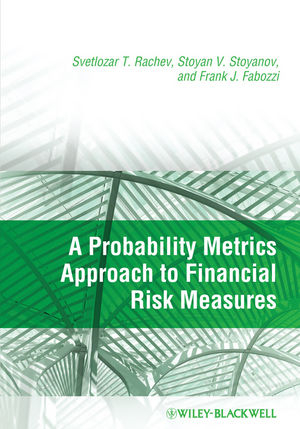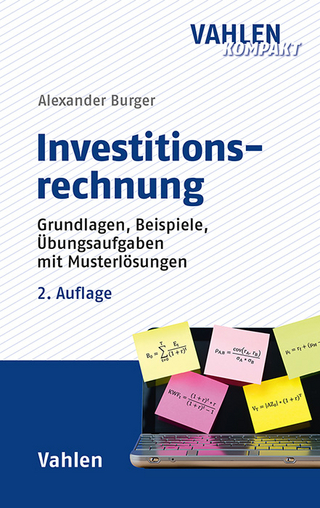
A Probability Metrics Approach to Financial Risk Measures
Wiley-Blackwell (Verlag)
978-1-4051-8369-7 (ISBN)
A Probability Metrics Approach to Financial Risk Measures relates the field of probability metrics and risk measures to one another and applies them to finance for the first time.
Helps to answer the question: which risk measure is best for a given problem?
Finds new relations between existing classes of risk measures
Describes applications in finance and extends them where possible
Presents the theory of probability metrics in a more accessible form which would be appropriate for non-specialists in the field
Applications include optimal portfolio choice, risk theory, and numerical methods in finance
Topics requiring more mathematical rigor and detail are included in technical appendices to chapters
Svetlozar (Zari) T. Rachev is Chair-Professor in Statistics, Econometrics and Mathematical Finance at the University of Karlsruhe in the School of Economics and Business Engineering. He is also Professor Emeritus at the University of California, Santa Barbara in the Department of Statistics and Applied Probability. He has published seven monographs, eight handbooks and special-edited volumes, and over 300 research articles. His recently coauthored books published by Wiley in mathematical finance and financial econometrics include Fat-Tailed and Skewed Asset Return Distributions: Implications for Risk Management, Portfolio selection, and Option Pricing (2005), Operational Risk: A Guide to Basel II Capital Requirements, Models, and Analysis (2007), Financial Econometrics: From Basics to Advanced Modeling Techniques (2007), and Bayesian Methods in Finance (2008). He is cofounder of Bravo Group, now FinAnalytica, specializing in financial risk-management software, for which he serves as Chief Scientist. Stoyan V. Stoyanov, Ph.D. is the Head of Quantitative Research at FinAnalytica specializing in financial risk management software. He is author and co-author of numerous papers some of which have recently appeared in Economics Letters, Journal of Banking and Finance, Applied Mathematical Finance, Applied Financial Economics, and International Journal of Theoretical and Applied Finance. He is a coauthor of the mathematical finance book Advanced Stochastic Models, Risk Assessment and Portfolio Optimization: the Ideal Risk, Uncertainty and Performance Measures (2008) published by Wiley. Dr. Stoyanov has years of experience in applying optimal portfolio theory and market risk estimation methods when solving practical problems of clients of FinAnalytica. Frank J. Fabozzi is Professor in the Practice of Finance in the School of Management at Yale University. Prior to joining the Yale faculty, he was a Visiting Professor of Finance in the Sloan School at MIT. Professor Fabozzi is a Fellow of the International Center for Finance at Yale University and on the Advisory Council for the Department of Operations Research and Financial Engineering at Princeton University. He is the editor of the Journal of Portfolio Management. His recently coauthored books published by Wiley in mathematical finance and financial econometrics include The Mathematics of Financial Modeling and Investment Management (2004), Financial Modeling of the Equity Market: From CAPM to Cointegration (2006), Robust Portfolio Optimization and Management (2007), Financial Econometrics: From Basics to Advanced Modeling Techniques (2007), and Bayesian Methods in Finance (2008).
Preface xiii
About the Authors xv
1 Introduction 1
1.1 Probability Metrics 1
1.2 Applications in Finance 2
2 Probability Distances and Metrics 7
2.1 Introduction 9
2.2 Some Examples of Probability Metrics 9
2.2.1 Engineer’s metric 10
2.2.2 Uniform (or Kolmogorov) metric 10
2.2.3 Lévy metric 11
2.2.4 Kantorovich metric 14
2.2.5 Lp-metrics between distribution functions 15
2.2.6 Ky Fan metrics 16
2.2.7 Lp-metric 17
2.3 Distance and Semidistance Spaces 19
2.4 Definitions of Probability Distances and Metrics 24
2.5 Summary 28
2.6 Technical Appendix 28
2.6.1 Universally measurable separable metric spaces 29
2.6.2 The equivalence of the notions of p. (semi-)distance on P2 and on X 35
3 Choice under Uncertainty 40
3.1 Introduction 41
3.2 Expected Utility Theory 44
3.2.1 St Petersburg Paradox 44
3.2.2 The von Neumann–Morgenstern expected utility theory 46
3.2.3 Types of utility functions 48
3.3 Stochastic Dominance 51
3.3.1 First-order stochastic dominance 52
3.3.2 Second-order stochastic dominance 53
3.3.3 Rothschild–Stiglitz stochastic dominance 55
3.3.4 Third-order stochastic dominance 56
3.3.5 Efficient sets and the portfolio choice problem 58
3.3.6 Return versus payoff 59
3.4 Probability Metrics and Stochastic Dominance 63
3.5 Cumulative Prospect Theory 66
3.6 Summary 70
3.7 Technical Appendix 70
3.7.1 The axioms of choice 71
3.7.2 Stochastic dominance relations of order n 72
3.7.3 Return versus payoff and stochastic dominance 74
3.7.4 Other stochastic dominance relations 76
4 A Classification of Probability Distances 83
4.1 Introduction 86
4.2 Primary Distances and Primary Metrics 86
4.3 Simple Distances and Metrics 90
4.4 Compound Distances and Moment Functions 99
4.5 Ideal Probability Metrics 105
4.5.1 Interpretation and examples of ideal probability metrics 107
4.5.2 Conditions for boundedness of ideal probability metrics 112
4.6 Summary 114
4.7 Technical Appendix 114
4.7.1 Examples of primary distances 114
4.7.2 Examples of simple distances 118
4.7.3 Examples of compound distances 131
4.7.4 Examples of moment functions 135
5 Risk and Uncertainty 146
5.1 Introduction 147
5.2 Measures of Dispersion 150
5.2.1 Standard deviation 151
5.2.2 Mean absolute deviation 153
5.2.3 Semi-standard deviation 154
5.2.4 Axiomatic description 155
5.2.5 Deviation measures 156
5.3 Probability Metrics and Dispersion Measures 158
5.4 Measures of Risk 159
5.4.1 Value-at-risk 160
5.4.2 Computing portfolio VaR in practice 165
5.4.3 Back-testing of VaR 172
5.4.4 Coherent risk measures 175
5.5 Risk Measures and Dispersion Measures 179
5.6 Risk Measures and Stochastic Orders 181
5.7 Summary 182
5.8 Technical Appendix 183
5.8.1 Convex risk measures 183
5.8.2 Probability metrics and deviation measures 184
5.8.3 Deviation measures and probability quasi-metrics 187
6 Average Value-at-Risk 191
6.1 Introduction 192
6.2 Average Value-at-Risk 193
6.2.1 AVaR for stable distributions 200
6.3 AVaR Estimation from a Sample 204
6.4 Computing Portfolio AVaR in Practice 207
6.4.1 The multivariate normal assumption 207
6.4.2 The historical method 208
6.4.3 The hybrid method 208
6.4.4 The Monte Carlo method 209
6.4.5 Kernel methods 211
6.5 Back-testing of AVaR 218
6.6 Spectral Risk Measures 220
6.7 Risk Measures and Probability Metrics 223
6.8 Risk Measures Based on Distortion Functionals 226
6.9 Summary 227
6.10 Technical Appendix 228
6.10.1 Characteristics of conditional loss distributions 228
6.10.2 Higher-order AVaR 232
6.10.3 The minimization formula for AVaR 234
6.10.4 ETL vs AVaR 237
6.10.5 Kernel-based estimation of AVaR 242
6.10.6 Remarks on spectral risk measures 245
7 Computing AVaR through Monte Carlo 252
7.1 Introduction 253
7.2 An Illustration of Monte Carlo Variability 256
7.3 Asymptotic Distribution, Classical Conditions 259
7.4 Rate of Convergence to the Normal Distribution 262
7.4.1 The effect of tail thickness 263
7.4.2 The effect of tail truncation 268
7.4.3 Infinite variance distributions 271
7.5 Asymptotic Distribution, Heavy-tailed Returns 277
7.6 Rate of Convergence, Heavy-tailed Returns 283
7.6.1 Stable Paretian distributions 283
7.6.2 Student’s t distribution 286
7.7 On the Choice of a Distributional Model 290
7.7.1 Tail behavior and return frequency 290
7.7.2 Practical implications 295
7.8 Summary 297
7.9 Technical Appendix 298
7.9.1 Proof of the stable limit result 298
8 Stochastic Dominance Revisited 304
8.1 Introduction 306
8.2 Metrization of Preference Relations 308
8.3 The Hausdorff Metric Structure 310
8.4 Examples 314
8.4.1 The L´evy quasi-semidistance and first-order stochastic dominance 315
8.4.2 Higher-order stochastic dominance 317
8.4.3 The H-quasi-semidistance 320
8.4.4 AVaR generated stochastic orders 322
8.4.5 Compound quasi-semidistances 324
8.5 Utility-type Representations 325
8.6 Almost Stochastic Orders and Degree of Violation 328
8.7 Summary 330
8.8 Technical Appendix 332
8.8.1 Preference relations and topology 332
8.8.2 Quasi-semidistances and preference relations 334
8.8.3 Construction of quasi-semidistances on classes of investors 335
8.8.4 Investors with balanced views 338
8.8.5 Structural classification of probability distances 339
Index 357
| Erscheint lt. Verlag | 21.1.2011 |
|---|---|
| Verlagsort | Hoboken |
| Sprache | englisch |
| Maße | 160 x 239 mm |
| Gewicht | 703 g |
| Themenwelt | Wirtschaft ► Betriebswirtschaft / Management ► Finanzierung |
| Wirtschaft ► Volkswirtschaftslehre ► Ökonometrie | |
| ISBN-10 | 1-4051-8369-1 / 1405183691 |
| ISBN-13 | 978-1-4051-8369-7 / 9781405183697 |
| Zustand | Neuware |
| Haben Sie eine Frage zum Produkt? |
aus dem Bereich


